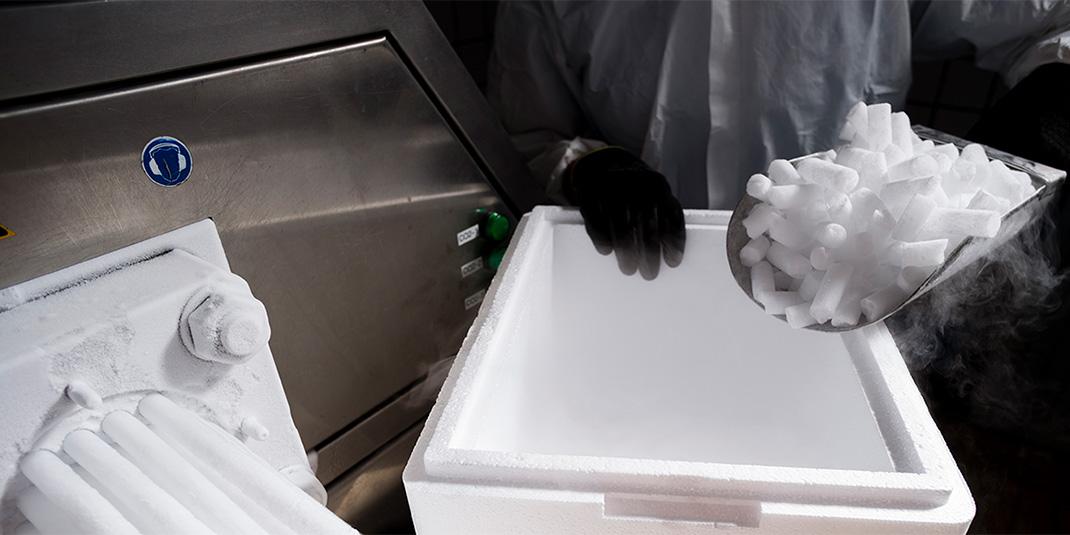For Cryogenic Samples, Dry Ice Is Unwise

To avoid deterioration, cryogenic samples are generally stored in liquid nitrogen or its vapor phase at temperatures around -170°C. During transport, some scientists place these samples on dry ice. However, research shows putting cryogenic samples on dry ice can warm them faster than exposure to room temperature. The culprits: convection and conduction.
Cryogenic samples such as eukaryotic cell-based therapeutics require storage at temperatures below the threshold for the glass transition phase of water (Tg-H2O, approximately -135°C). Storage under those conditions avoids biological activity and minimizes loss of post-thaw cell viability.1 Keeping eukaryotic cell solutions at temperatures higher than Tg-H2O introduces serious risks. When encapsulated liver cell spheroids were stored at -80°C, decreased viable cell numbers and cell function were detected after just one month of storage compared with the same cells stored at -170°C.2 Liquid nitrogen (LN2) and its vapor phase provide a safe environment for such samples, maintaining temperatures at around -170°C or lower. LN2, first produced in 1883 by Polish physicists, is now used as a coolant in many industrial environments from computers to cameras – and superconductors to vacuum pumps. It is indispensable in any research that involves cryogenic samples.
An alternative medium often used in biomedical and molecular biology research for temperature management is dry ice, the solid form of carbon dioxide. This material sublimates at -78°C, and its uses are as varied as those for liquid nitrogen. Many laboratories rely on dry ice to maintain a cold environment during transport of their biological materials. However, transporting biosamples on dry ice has some surprising and important drawbacks. Studies show that dry ice results in acidification of sample solutions stored in screwcap tubes and potentially affects protein stability.3 Moreover, post-thaw viability of human lymphocytes suspended in 10 percent DMSO was markedly decreased when they were shipped on dry ice compared to shipment in LN2 vapor-phase.4
The most surprising result was obtained in tests where 2ml vials of cryogenic samples were transferred from their liquid nitrogen environment into dry ice with their temperatures continuously monitored. The samples reached and surpassed the glass transition temperature of water within 15 to 25 seconds after placement in dry ice.5 Astoundingly, this was about two times faster than when these samples were exposed to the ambient environment. How could this be?
The explanation lies in two physical phenomena: convection and conduction.
First, the carbon dioxide sublimation of dry ice results in a microenvironment with enhanced convection – i.e. directed movement of molecules within fluids such as gases. Much like in a convection oven, this effect enables increased heat transmission to any matter placed into this environment. The outcome is an accelerated warm-up of cryogenic samples up to the temperature of the dry ice (-78°C). This warm-up is substantial, as dry ice is about 90°C warmer than the LN2 vapor storage environment of those samples.
Second, the direct contact of the cryogenic tube walls with the dry ice caused an enhanced conductive heat transfer via direct molecular collision to the cryogenic sample tube.5 So, researchers who seek to protect their cryogenic material from warming by placing it into dry ice during short transport achieve quite the opposite: a faster warm-up to temperatures above Tg-H2O.
How can such warming events be avoided? Simple. Never placing cryogenic samples into an environment warmer than -135°C. Fortunately, solutions that enable transport of cryogenic samples under these temperatures exist.
Azenta Life Sciences offers the cost-effective CryoPod™ Carrier – a portable LN2 vapor-based and lightweight piece of equipment that reliably holds samples at -150°C or colder for over four hours. With this device, scientists can effectively avoid thermal excursions of their valuable cryogenic samples during handling or transport. This is the reason why it is recommended among best practices for handling cryopreserved cell suspensions.
References
1. Hubel A., Spindler R., Skubitz A. Storage of Human Biospecimens: Selection of the Optimal Storage Temperature. Biopreservation and Biobanking. 2014. 12(3): 165-175. DOI: 10.1089/bio.2013.0084. https://www.ncbi.nlm.nih.gov/pubmed/24918763
2. Massie I., Selden C., Hodgson H., Fuller B. Storage temperatures for cold-chain delivery in cell therapy: A study of alginate-encapsulated liver cell spheroids stored at - 80°C or -170°C for up to 1 year. Tissue Engineer Part C: Methods. 2013. 19(3):189–195. doi: 10.1089/ten.tec.2012.0307 https://www.ncbi.nlm.nih.gov/pmc/articles/PMC3557435/
3. Murphy BM, Swarts S, Mueller BM, van der Geer P, Manning MC, Fitchmun MI. Protein instability following transport or storage on dry ice. Nat Methods. 2013. 10(4):278-9. doi: 10.1038/nmeth.2409. https://www.nature.com/articles/nmeth.2409.pdf
4. Kofanova OA1, Davis K, Glazer B, De Souza Y, Kessler J, Betsou F; ISBER Biospecimen Science Working Group. Viable mononuclear cell stability study for implementation in a proficiency testing program: impact of shipment conditions. Biopreserv Biobank. 2014. 12(3):206-16. doi: 10.1089/bio.2013.0090. https://www.ncbi.nlm.nih.gov/pmc/articles/PMC4955601/
5. Salvetti, M., Fink, J. Barlett, A., Stira, M., Warhurst, J. Thermal excursions of cryogenically frozen vials (below -150°C) and the risk of rising above Tg: analyzing warm-up rates from cryogenic storage to both dry ice and ambient temperature environments. Cytotherapy. 2015. 17(6):S26. https://www.labrepco.com/data/file-downloads/Thermal_excursions_of_cryogenically_frozen_vials__below_-150C__and_the_risk_of_rising_above_Tg_H2O_with_both_dry_ice_and_ambient_environments_1485467833.pdf
6. Simione F, Sharp T. Best practices for storing and shipping cryopreserved cells. In Vitro Cell Dev Biol Anim. 2017. 53(10):888-895. doi: 10.1007/s11626-017-0214-6. https://link.springer.com/article/10.1007%2Fs11626-017-0214-6